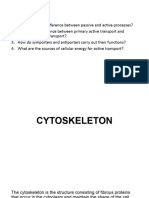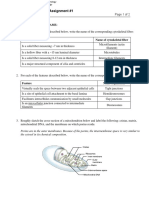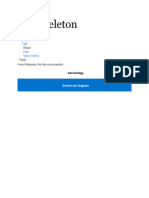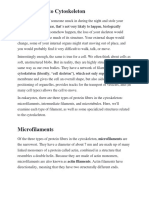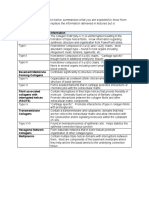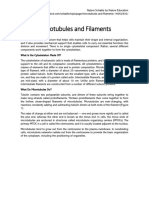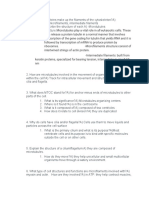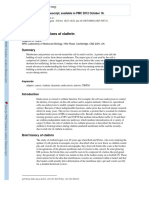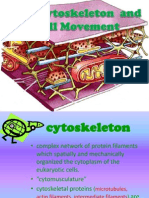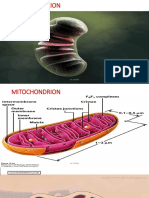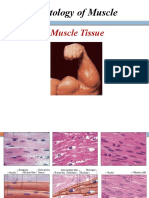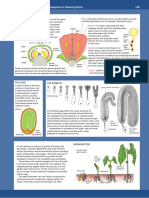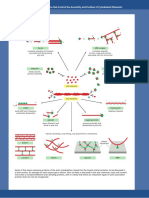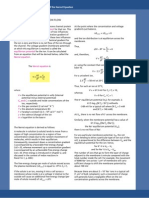Professional Documents
Culture Documents
Actin Filaments: 968 PANEL 16-1: The Three Major Types of Protein Filaments That Form The Cytoskeleton
Uploaded by
JohnOriginal Title
Copyright
Available Formats
Share this document
Did you find this document useful?
Is this content inappropriate?
Report this DocumentCopyright:
Available Formats
Actin Filaments: 968 PANEL 16-1: The Three Major Types of Protein Filaments That Form The Cytoskeleton
Uploaded by
JohnCopyright:
Available Formats
968
PANEL 161: The Three Major Types of Protein Filaments That Form the Cytoskeleton
ACTIN FILAMENTS
ii
iii
100 nm
iv
25 nm
Actin filaments (also known as microfilaments) are two-stranded helical
polymers of the protein actin. They appear as flexible structures, with a
diameter of 59 nm, and they are organized into a variety of linear bundles,
two-dimensional networks, and three-dimensional gels. Although actin
filaments are dispersed throughout the cell, they are most highly
concentrated in the cortex, just beneath the plasma membrane.
Micrographs courtesy of Roger Craig (i and iv); P.T. Matsudaira and D.R. Burgess (ii); Keith Burridge (iii).
MICROTUBULES
ii
100 nm
iii
iv
25 nm
Microtubules are long, hollow cylinders made of the protein tubulin.
With an outer diameter of 25 nm, they are much more rigid than actin
filaments. Microtubules are long and straight and typically have one
end attached to a single microtubule-organizing center (MTOC)
called a centrosome.
Micrographs courtesy of Richard Wade (i); D.T. Woodrow and R.W. Linck (ii); David Shima (iii); A. Desai (iv).
INTERMEDIATE FILAMENTS
ii
iii
100 nm
iv
25 nm
Intermediate filaments are ropelike fibers with a diameter of around
10 nm; they are made of intermediate filament proteins, which constitute a
large and heterogeneous family. One type of intermediate filament forms a
meshwork called the nuclear lamina just beneath the inner nuclear
membrane. Other types extend across the cytoplasm, giving cells mechanical
strength. In an epithelial tissue, they span the cytoplasm from one cell-cell
junction to another, thereby strengthening the entire epithelium.
Micrographs courtesy of Roy Quinlan (i); Nancy L. Kedersha (ii); Mary Osborn (iii); Ueli Aebi (iv).
You might also like
- Cytoskeleton SNDocument3 pagesCytoskeleton SNsamy gNo ratings yet
- Centro, MF. Module - 6.Document9 pagesCentro, MF. Module - 6.jessa marie marevilesNo ratings yet
- 4.1 CytoskeletonDocument28 pages4.1 Cytoskeletonedabzan234No ratings yet
- Cytoskeleton MADocument22 pagesCytoskeleton MAsema raraNo ratings yet
- Thecytoskeleton PPTDocument11 pagesThecytoskeleton PPTseenu mohapatraNo ratings yet
- Principles of Human Pathology HomeworkDocument2 pagesPrinciples of Human Pathology HomeworkAliza Dewi FortuaNo ratings yet
- Cells Cytoskeleton TaskDocument2 pagesCells Cytoskeleton TaskHinKNo ratings yet
- CytoskeletonDocument9 pagesCytoskeletonGordon YapNo ratings yet
- CELL-THE UNIT OF LIFE-Ribosomes, CytoskeletonDocument19 pagesCELL-THE UNIT OF LIFE-Ribosomes, CytoskeletonHridyanshu Singh RoyNo ratings yet
- CytoskeletonDocument2 pagesCytoskeletonastro paculanNo ratings yet
- 14 The CytoskeletonDocument7 pages14 The Cytoskeletonsatriamanullang880No ratings yet
- Prepared By:-: Priyanka Yadav M.Sc. Life Sciences Ist SemDocument37 pagesPrepared By:-: Priyanka Yadav M.Sc. Life Sciences Ist SemleartaNo ratings yet
- CytoskeletonDocument9 pagesCytoskeletonQuoc KhanhNo ratings yet
- The CytoskeletonDocument63 pagesThe CytoskeletonAmara TargaryenNo ratings yet
- Mitotic Spindles Revisited - New Insights From 3D Electron MicrosDocument8 pagesMitotic Spindles Revisited - New Insights From 3D Electron MicrosClara Daniela Charry MarinNo ratings yet
- CollagensDocument1 pageCollagensajasdajsNo ratings yet
- CollagensDocument1 pageCollagensajasdajsNo ratings yet
- Table 6.2. This Does Not Replace The Information Delivered in Lectures But Is Complimentary To It)Document1 pageTable 6.2. This Does Not Replace The Information Delivered in Lectures But Is Complimentary To It)ajasdajsNo ratings yet
- Cytoskeleton Actividad 28-03 PDFDocument9 pagesCytoskeleton Actividad 28-03 PDFCatalina YáñezNo ratings yet
- CytoskeletonDocument7 pagesCytoskeletonyannahlrNo ratings yet
- Cytoskeleton EngDocument7 pagesCytoskeleton EngTha Joon Lautner MatsuyamaNo ratings yet
- Collagen StructureDocument17 pagesCollagen StructureMontserrat LandaNo ratings yet
- Muscle Physiology 2Document29 pagesMuscle Physiology 2Ayesha IqbalNo ratings yet
- Chapter 9 Actin FloresDocument39 pagesChapter 9 Actin FloresPATRICK MARK FLORESNo ratings yet
- Molecular Bio Lecture 13Document38 pagesMolecular Bio Lecture 13AngryNo ratings yet
- Nithilan NathanDocument8 pagesNithilan NathanVashniie TabithaNo ratings yet
- 2cytology Cytoskel Receptor Transp (3) 1Document43 pages2cytology Cytoskel Receptor Transp (3) 1m.mansoor3377No ratings yet
- Duplichecker Plagiarism ReportDocument2 pagesDuplichecker Plagiarism ReportAshwaniNo ratings yet
- Cytoskeleton 2Document7 pagesCytoskeleton 2Basil Francis AlajidNo ratings yet
- B GENERAL BIOLOGY I Q1M3.1 Learner-Copy Final LayoutDocument10 pagesB GENERAL BIOLOGY I Q1M3.1 Learner-Copy Final LayoutLiennar NaikhNo ratings yet
- Biomed 05Document12 pagesBiomed 05api-3706483No ratings yet
- Cell Size and Shape - : Cells Ii: Cellular OrganizationDocument27 pagesCell Size and Shape - : Cells Ii: Cellular OrganizationcadimogirlNo ratings yet
- Cytoskeleton PRESENTATIONDocument36 pagesCytoskeleton PRESENTATIONChaudryNomiNo ratings yet
- CMB Lect 1 2011 Colour 2 Slides PDFDocument20 pagesCMB Lect 1 2011 Colour 2 Slides PDFjf5014No ratings yet
- Ch3 - Contractile Mechanisms in Skeletal MuscleDocument13 pagesCh3 - Contractile Mechanisms in Skeletal MuscleLinh Chi NguyễnNo ratings yet
- Cell-Y-Wood Presentation-2Document11 pagesCell-Y-Wood Presentation-2api-358704014No ratings yet
- (Doi 10.1016 - s0065-3233 (05) 70001-2) Parry, David A.D. - (Advances in Protein Chemistry) Fibrous Proteins - Coiled-Coils, Collagen and Elastomers Volume 70 - Fibrous Proteins - New StrucDocument10 pages(Doi 10.1016 - s0065-3233 (05) 70001-2) Parry, David A.D. - (Advances in Protein Chemistry) Fibrous Proteins - Coiled-Coils, Collagen and Elastomers Volume 70 - Fibrous Proteins - New StrucNia RukmanNo ratings yet
- AMINO ACIDS AND PROTEINS - THE CELL'S CYTOSKELETON AND ITS FUNCTIONS (38 charactersDocument2 pagesAMINO ACIDS AND PROTEINS - THE CELL'S CYTOSKELETON AND ITS FUNCTIONS (38 charactersyejiNo ratings yet
- Biochem AssignmentDocument2 pagesBiochem AssignmentAngel GoNo ratings yet
- Cell Size and Shape - : Back To TopDocument30 pagesCell Size and Shape - : Back To TopPraveen SelvarajNo ratings yet
- Cy To SkeletonDocument10 pagesCy To SkeletonWaqas KhanNo ratings yet
- PRQ7Document2 pagesPRQ7glody mbokoNo ratings yet
- Microscopic Anatomy of A Skeletal Muscle FiberDocument33 pagesMicroscopic Anatomy of A Skeletal Muscle FiberKumar MSNo ratings yet
- Cytoskeleton: Cell's Internal StructureDocument1 pageCytoskeleton: Cell's Internal Structured-fbuser-68486715No ratings yet
- The Celullar Function of ClathrinDocument17 pagesThe Celullar Function of ClathrinJeli MangoloNo ratings yet
- Understanding the Dynamic CytoskeletonDocument66 pagesUnderstanding the Dynamic CytoskeletonChristian Santiago100% (1)
- CytoskeletonDocument27 pagesCytoskeletonserenity limNo ratings yet
- Cytoskeleton:: Network Within The Cytoplasm ThatDocument4 pagesCytoskeleton:: Network Within The Cytoplasm ThatSoto Agudelo RicardoNo ratings yet
- Cy To SkeletonDocument17 pagesCy To SkeletonKitkat AlorroNo ratings yet
- Cell Lecture 3Document18 pagesCell Lecture 3haamajansiNo ratings yet
- Histology of MuscleDocument49 pagesHistology of MuscleTewachew Dessie100% (1)
- Cell Structure and Function NotesDocument7 pagesCell Structure and Function Notessourav9823No ratings yet
- 5 - Cytoskeleton and Cell MotilityDocument21 pages5 - Cytoskeleton and Cell Motilitywhether913No ratings yet
- Cell Biology Part 4 FinalDocument23 pagesCell Biology Part 4 FinalVittal Athul RNo ratings yet
- FirbomatnedonDocument7 pagesFirbomatnedonAbiyoga PramanaNo ratings yet
- 11.sitoskeleton Dan Pergerakan Sel-Dr - IsraDocument40 pages11.sitoskeleton Dan Pergerakan Sel-Dr - IsraTa RaNo ratings yet
- Chapter VI - Contraction of The Skeletal Muscle: Filamentous Bands Light Bands Dark BandsDocument13 pagesChapter VI - Contraction of The Skeletal Muscle: Filamentous Bands Light Bands Dark BandsLorenz L. Llamas IIINo ratings yet
- Contractile Tissues NotesDocument89 pagesContractile Tissues NotesteeNo ratings yet
- CTO 17 Form Assess Qus0910Document16 pagesCTO 17 Form Assess Qus0910becca_smith13No ratings yet
- Semicond LasersDocument23 pagesSemicond LasersurimNo ratings yet
- MIT3 091SCF09 SummaryDocument33 pagesMIT3 091SCF09 SummarydavidraaamosNo ratings yet
- ChimieDocument10 pagesChimieDana CapbunNo ratings yet
- 508 Lecture 12Document3 pages508 Lecture 12JohnNo ratings yet
- Quimica Organica IIDocument18 pagesQuimica Organica IIvskywokervsNo ratings yet
- Statics SlidesDocument35 pagesStatics SlidesHabibullah RadziNo ratings yet
- AP Chem NotesDocument45 pagesAP Chem NotesSajiveSivalingamNo ratings yet
- Chemistry 101 Complete NotesDocument323 pagesChemistry 101 Complete NotesEnerolisa Paredes100% (1)
- The Stock Market Jumpstarter V2.0Document51 pagesThe Stock Market Jumpstarter V2.0Dennis LandichoNo ratings yet
- AcDocument44 pagesAcJohnNo ratings yet
- IPLS Report 2015 v2Document40 pagesIPLS Report 2015 v2JohnNo ratings yet
- Open Educational Resources Textbook ListDocument35 pagesOpen Educational Resources Textbook ListJohn100% (1)
- Spie Trial ManualDocument9 pagesSpie Trial ManualJohnNo ratings yet
- X Ray Diffraction 1057Document5 pagesX Ray Diffraction 1057JohnNo ratings yet
- Thermodynamics: Course IntroductionDocument52 pagesThermodynamics: Course IntroductionRodrigo Silveira da SilveiraNo ratings yet
- XML For Software Engineers: Tutorial OutlineDocument47 pagesXML For Software Engineers: Tutorial OutlineJohnNo ratings yet
- The Effect of Vibrational Excitation of Molecules Involving Methane & NitrogenDocument15 pagesThe Effect of Vibrational Excitation of Molecules Involving Methane & NitrogenRay FraustoNo ratings yet
- Redox PotentialsDocument1 pageRedox PotentialsJohnNo ratings yet
- Fourier Problem and AnswerDocument2 pagesFourier Problem and AnswerJohnNo ratings yet
- Flower DevelopmentDocument1 pageFlower DevelopmentJohnNo ratings yet
- Plant Tissue SystemsDocument2 pagesPlant Tissue SystemsJohn0% (1)
- Exponential Notation and Physical QuantitiesDocument4 pagesExponential Notation and Physical QuantitiesJohnNo ratings yet
- PolymerizationDocument2 pagesPolymerizationJohnNo ratings yet
- M Phase in An Animal CellDocument2 pagesM Phase in An Animal CellJohnNo ratings yet
- Molecular MechanismsDocument2 pagesMolecular MechanismsJohnNo ratings yet
- Actin Filaments and MicrotubulesDocument2 pagesActin Filaments and MicrotubulesJohnNo ratings yet
- Signal Sequences and Protein TranslocationDocument1 pageSignal Sequences and Protein TranslocationJohnNo ratings yet
- Squid Giant AxonDocument1 pageSquid Giant AxonJohnNo ratings yet
- Panel 11-2Document1 pagePanel 11-2nrf2No ratings yet



